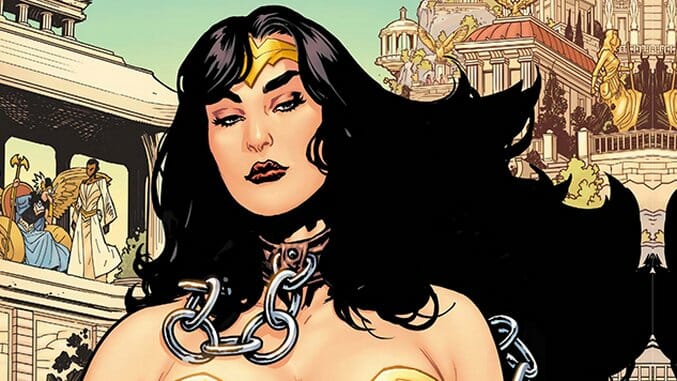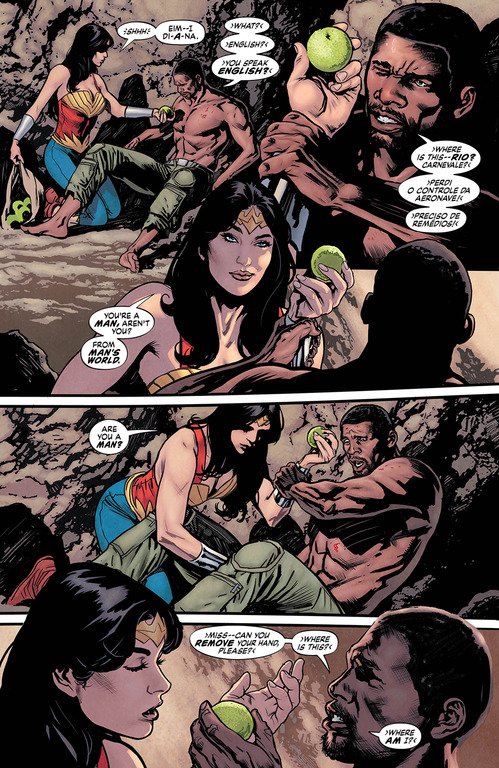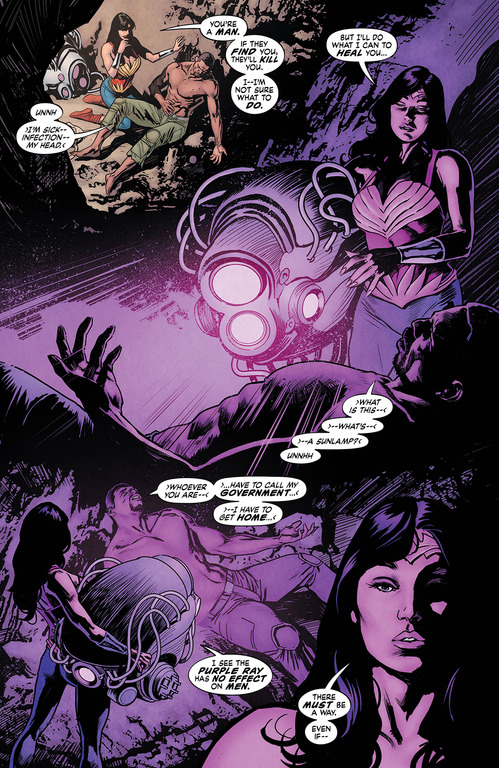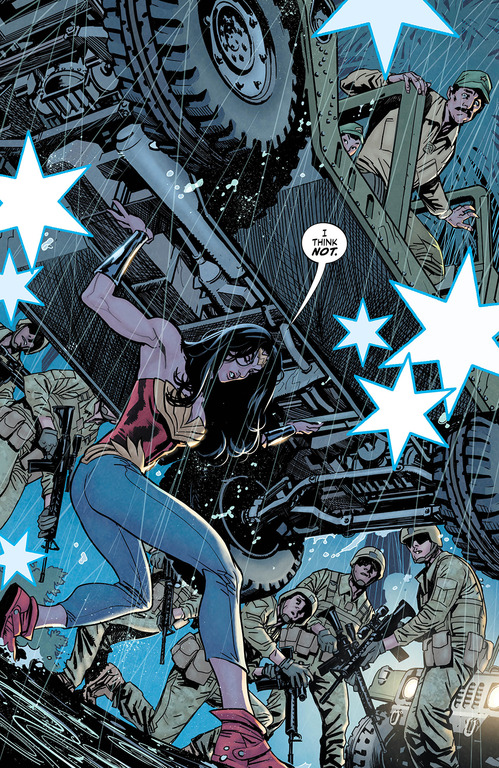
Writer: Grant Morrison
Artist: Yanick Paquette
Colorist: Nathan Fairbairn
Publisher: DC Comics
Big Spoilers Ahead
The first two scenes in Grant Morrison and Yanick Paquette’s Wonder Woman: Earth One feature two very different portrayals of bondage.
In the first, Hercules—a hairy tower of testosterone and hubris—winds a chain around the neck of Hippolyta, Wonder Woman’s mother. He growls sexual, demeaning commands like “To heel, bitch of Hercules,” echoing a gonzo porn despot. He gropes her buttocks before she strangles him with her former constraints.
The second scenario features chains far less heavy. Four Amazons lead Wonder Woman to her mother in a leather dog collar to account for a crime revealed throughout the rest of the book. “I understand,” Wonder Woman says. “This was my decision”—the words My and Decision rendered in obsidian-black, slanted text. Words that stand out on the page like a marquee billboard.
The contrast between the two scenes is a perfect representation of the tug-of-war at the heart of the graphic novel—submission vs. defiance, obedience vs. rebellion, fatalism vs. freedom. It’s also a reconciliation of ideas stretching back to Wonder Woman’s inception in 1941.
Writer Grant Morrison, a cultural omnivore and godfather of literary comic books, hasn’t always loved Wonder Woman. In a 2009 interview with Newsarama, Morrison said, “When I dug into the roots of the character I found an uneasy melange of girl power, bondage and disturbed sexuality that has never been adequately dealt with or fully processed out to my mind. I’ve always felt there was something oddly artificial about Wonder Woman, something not like a woman at all.” He’s certainly not the only one who’s felt that way.

Wonder Woman: Earth One Interior Art by Yanick Paquette and Nathan Fairbairn, Courtesy DC Entertainment
New Yorker staff writer and Harvard Scholar Jill Lepore diagrammed the character’s origins in The Secret History of Wonder Woman, and it’s equally amazing and weird. Creator and psychologist William Moulton Marston used the character as a symbol of the suffrage movement and his own libertine sexual views. Marston gave her a lasso that forced those it ensnared to tell the truth—a reference to the women who chained themselves to The White House and to the first lie detector test, which he created. Marston also enjoyed bondage and polyamory, and Olive Byrne, the woman with whom Martson and his wife Elizabeth Holloway Marston cultivated an extended relationship, was the niece of none other than birth control prophet Margaret Sanger. Whether the man conceived a fictional feminist revolutionary or his own sexual idol (or both) is up for interpretation. Lepore herself questioned the dichotomy: “Is this a feminist project that’s supposed to help girls decide to go to college and have careers, or is this just like soft porn?”
Morrison attempts to answer that question with grace and class, offering a heroine who transcends her history’s chains to become a far more benevolent figure. The book loosely reconstructs Wonder Woman’s first story: living on the ladies-only Paradise Island, Diana comes across a crashed military plane and its wounded pilot, Steve Trevor. Rather than turn the visitor in for a “humane” death as mandated by her mother and queen, Hippolyta, Wonder Woman travels outside the island to return Trevor to his home in America.
Morrison told Paste last year that Wonder Woman: Earth One isn’t “reliant on the structure of boys adventure fiction,” and those words couldn’t be more true. The graphic novel follows neither a hero’s conventional journey nor the good-vs-evil canvass it inhabits.

Wonder Woman: Earth One Interior Art by Yanick Paquette and Nathan Fairbairn, Courtesy DC Entertainment
Wonder Woman berates an onslaught of soldiers, calling them boys leading “brief, ignorant lives of fear and conflict.” She then spends the rest of the comic proving their violent antagonism wrong. Only a single struggle here is solved through a KO. Morrison even summons one of Greek mythology’s great, hideous monsters, setting the stage for an epic showdown. The fiend inflicts its damage and leaves the scene unscathed and unheard from again, a hilarious middle-finger to the superhero comic formula.
Yanick Paquette’s art celebrates the clear confidence of Diana and the Amazons, their posture immaculately proud and natural. He contrasts that body language with the aforementioned monster and various Americans, showing physiques small and quivering in the wake of godhood. His paneling also embraces a huge swath of creativity, using Greco pot ornamentation, winding gold thread and other flourishes to tell the story with appropriate iconography. Colorist Nathan Fairbairn nails the sun-doused precipices and natural colors, and when the story veers into the antiseptic halls of an American hospital, the absence of natural light is tangible.

Wonder Woman: Earth One Interior Art by Yanick Paquette and Nathan Fairbairn, Courtesy DC Entertainment
In these pages, Wonder Woman is a healer, diplomat and teacher of impenetrable resolve, submitting and rebelling strategically for the good of those around her. That glorious truth feels unfortunately rushed within 144 pages, if nonetheless triumphant. Morrison plants a host of side plots exploring the technology and mythology of Diana’s world, as well as the culture shock when she visits the outside world. That brevity puts chains far more restricting around this book than any links weighing down Wonder Woman.
The titular character’s sexuality is addressed, if not resolved. Comic relief Elizabeth Candy—a sorority sister saved by Wonder Woman who serves as a witness at her trial—offers a reader proxy of the character’s past with Rebel Wilson snark. And though dialogue like “Paradise Island of science fiction lesbians with a side of bondage” raises a smile, the bridge between Marston’s bizarre vision and Morrison’s progressive take only forms the most indirect connection. Maybe that’s for the best.
